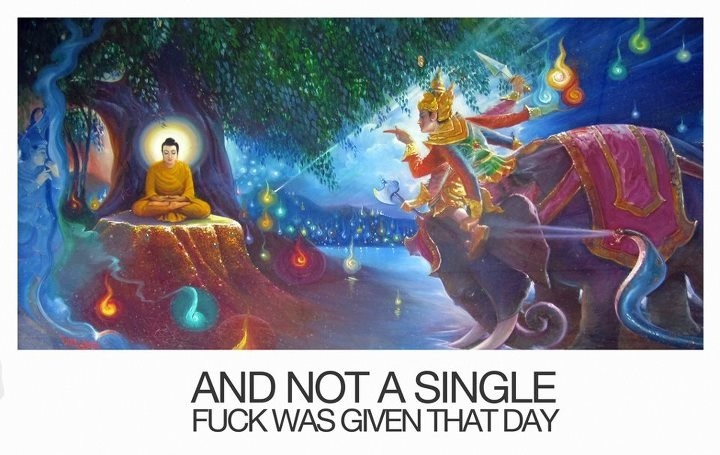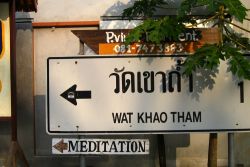 The first time I heard about vipassana retreats was last year, one year later the right time finally came and I went to one. Vipassana is a form of buddhist insight meditation. The technique is taught by S.R. Goenka under the hood of Vipassana Research Institute. VRI is a large organization, responsible for organizing hundreds of courses in different countries each year. Courses are free (including lodging and food), but you are allowed to make donation only after you complete the course. The basic course lasts ten days, plus two extra days reserved for arrival and departure. Over this period you are completely isolated from outside world, as well as other participants. No talking, no eye or physical contact, no mobile phones, no internet, no music, no books or writings, basically no entertainment of any kind. You are essentially left alone with your thoughts and there is nothing to distract you from them, like it or not. Sounds like fun, sign me in!
The first time I heard about vipassana retreats was last year, one year later the right time finally came and I went to one. Vipassana is a form of buddhist insight meditation. The technique is taught by S.R. Goenka under the hood of Vipassana Research Institute. VRI is a large organization, responsible for organizing hundreds of courses in different countries each year. Courses are free (including lodging and food), but you are allowed to make donation only after you complete the course. The basic course lasts ten days, plus two extra days reserved for arrival and departure. Over this period you are completely isolated from outside world, as well as other participants. No talking, no eye or physical contact, no mobile phones, no internet, no music, no books or writings, basically no entertainment of any kind. You are essentially left alone with your thoughts and there is nothing to distract you from them, like it or not. Sounds like fun, sign me in!
The retreat is located near Ödeshög in Western Sweden, 250km from Stockholm. The course-grounds are rather countryside: potato fields as far as eye can see, a lonely road and a few wind turbines on the horizon. Lovely. The organization of the course was top-notch and it really showed that they have got a lot of experience in organizing this tip of thing. There were no major hiccups I could notice and they always managed to stick to the daily schedule. The food was a pleasant surprise, as I was expecting no-thrills Rainbow Gathering type food, but we got porridge, müsli, cooked dry fruits for breakfast and versatile veggy meal completed with a dessert for a lunch. The supper offered just tea, milk and two fruits for new students and hot lemon water for old students. So the last real meal was around 11AM, but the only time I felt hungry was for the two hours after waking up before the breakfast. On a positive side a breakfast bell was something I really really looked forward into. Oh the joy of getting food after a 19 hours mini-fast. It puts a new meaning into the word “break-fast”. The schedule is pretty much the same every day: wake-up at 4AM, two hours of meditation, breakfast at 6.30AM, rest, three hours of meditation, lunch at 11AM, rest, three hours of meditation, evening tea at 5PM, rest, two hours of meditation, discourse at 7PM, half an hour of meditation and lights out at 10PM. Evening discourse addresses the issues of the day and provides some background information on Buddhism postulates. The discourses are filled with numerous jokes, anecdotes and Goenka’s charm (protip: avoid your native language discourses and go straight for the original English one) – a pleasant break from the otherwise monotonous day program. We actually laughed at some of Goenka’s jokes, I must admin the man has got the charisma and style. Despite the same program every day, each day was unique for me with its own up and down-sides. Same same, but different. The rigorous schedule makes sure that you have no time to get bored, as long as you are serious about your meditation practice. In fact, at times I felt I had not enough time to do all the free time activities, such a short walk in the forest (the length of the path is 155m), a nap, stretching, laundry and that’s about it as far as free time activities go. The observance of rules was not really enforced, so it is really up to you whether you follow the rules or not. Then again, you are there by your choice, so why break the rules that are there for your own benefit?
It was the most intense and useful things I have ever done. A mental marathon of ever-increasing intensity lasting for ten days and a huge reward waiting for you once you reach your goal. Thinking of all the progress I made during in just ten days makes me want to participate in another course right away. First few days were rather uneventful, lots of physical pain caused by constant sitting, but nothing dramatic. My mind was the sole form of conventional entertainment, including telling stories and jokes, showing porn and playing music to me. All intensified in a high-definition and long-play format. I had very little mental pain caused by the bored mind, as I am more or less accustomed to sitting. But the physical pain was a different beast. My prior experience was no help and my whole body ached for the first few days. It took me days only to find a right combination of sitting cushions and a sustainable sitting position. Once one-hour no-position-change sittings started, the pain came back with vengeance and became almost unbearable. However, in a few days the pain magically dissolved and turned into a rather pleasant feeling. Things started getting really weird for me on the fifth day and each new day brought more and more weirdness. Energy sensations flowing through the body; all kinds of weird a-ha moments; discovering that the body has its own wisdom; being unsure whether I should be scared or happy and so on. On the last three days things turned rather psychedelic with everything glowing around me, a super-energetic feeling, continuous meditation mode, all kinds of unfamiliar, sometimes scary sensations and crystal clear mind. I had read about such experiences, but it is easy to dismiss these reports as crackpot science. Actually having this kind of experience happing to you is a whole different matter.
All in all, it was a smooth ride for me with tons of useful observations and insights. A++, WOULD DO AGAIN. Now why would you go through to such a dramatic thing? First, you will get an experience unlike anything else. Achieving meditation states like this with nothing, but sitting and observing your mind is truly marvelous. Secondly, such an experience is useful to anyone and will change you for the better, no matter what your background is. Plus judging by what other experiences other people went through (e.g. grown-up men and women crying), such a course would do more good than years of psychotherapy.
www.dhamma.org
Some practical tips:
- If you decide to go, DO NOT QUIT NO MATTER WHAT. Your mind will make up all kinds of conspiracy theories and catastrophe scenarios, you will most likely become sick, you will find numerous reasons why you should quit, but do not do it. I promise when the course ends you will be very grateful that you did not quit.
- Do not try to beat the system. If it is meditation time, then meditate. There is nothing to do there anyway and you’ll get distracted by cheating attempts.
- Take care of your body. Take a nap when you feel to e.g. during breakfast and lunch rest times, stretch and take care of personal hygiene.
- A pair of earplugs is a good idea.
- Your body will most likely ache from constant sitting. You have to ride it out. If you have own sitting cushion, bring it with you. It will minimize the discomfort.
- Put yourself into the humble mode, it will tremendously ease up your stay there.
- Avoid lying meditation in the first few days, as you will fall asleep anyway. 🙂
- It is a good idea to reserve a few days after the retreat is over to reflect over the experience.
- Anicca anicca anicca
 Meditation is hard. I would say mastering own’s mind is the most difficult thing in the world. It is so hard that most people do not see any point in even starting sitting quietly observing own breathe. It took me 26 years to realise the caliber of the problem with human’s mind and how meditation can help. Progress in meditation is slow and mostly unnoticeable, which can be very frustrating. A retreat like this can really speed things up. A daily meditation practice is like walking from Moscow to Beijing. A 10 days retreat would be akin to taking a train on the way. Granted finishing the retreat is not an easy feat and I cannot say that it gets easier with time, but the benefit from such a course is enormous, no matter what your meditation background is (if any).
Meditation is hard. I would say mastering own’s mind is the most difficult thing in the world. It is so hard that most people do not see any point in even starting sitting quietly observing own breathe. It took me 26 years to realise the caliber of the problem with human’s mind and how meditation can help. Progress in meditation is slow and mostly unnoticeable, which can be very frustrating. A retreat like this can really speed things up. A daily meditation practice is like walking from Moscow to Beijing. A 10 days retreat would be akin to taking a train on the way. Granted finishing the retreat is not an easy feat and I cannot say that it gets easier with time, but the benefit from such a course is enormous, no matter what your meditation background is (if any).
